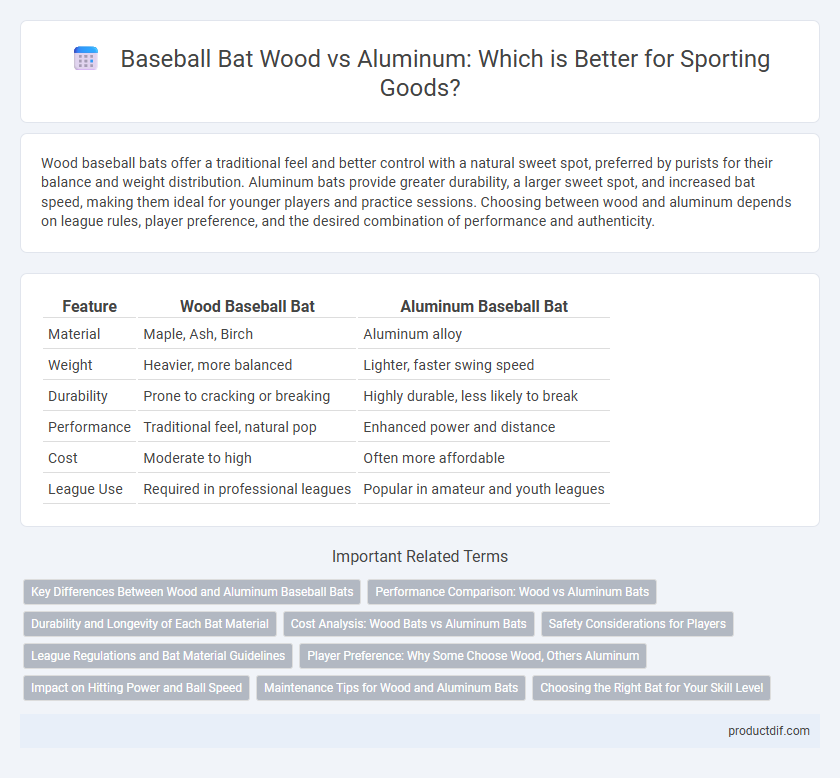Wood baseball bats offer a traditional feel and better control with a natural sweet spot, preferred by purists for their balance and weight distribution. Aluminum bats provide greater durability, a larger sweet spot, and increased bat speed, making them ideal for younger players and practice sessions. Choosing between wood and aluminum depends on league rules, player preference, and the desired combination of performance and authenticity.
Table of Comparison
| Feature | Wood Baseball Bat | Aluminum Baseball Bat |
|---|---|---|
| Material | Maple, Ash, Birch | Aluminum alloy |
| Weight | Heavier, more balanced | Lighter, faster swing speed |
| Durability | Prone to cracking or breaking | Highly durable, less likely to break |
| Performance | Traditional feel, natural pop | Enhanced power and distance |
| Cost | Moderate to high | Often more affordable |
| League Use | Required in professional leagues | Popular in amateur and youth leagues |
Key Differences Between Wood and Aluminum Baseball Bats
Wood baseball bats offer traditional craftsmanship with solid, natural materials that provide a heavier swing weight and a smaller sweet spot, enhancing control and precision. Aluminum bats are lighter, allowing faster swing speeds and a larger sweet spot, which often results in greater power and higher ball exit velocity. Durability also varies significantly, with aluminum bats resisting breakage and wood bats requiring more frequent replacement due to cracks and splintering.
Performance Comparison: Wood vs Aluminum Bats
Wood baseball bats deliver a traditional feel with superior balance and natural flex, enhancing control and swing accuracy, crucial for advanced players aiming for precision and contact. Aluminum bats offer a lighter weight, increased swing speed, and a larger sweet spot, resulting in higher ball exit velocity and greater hitting power, especially beneficial for younger or recreational athletes. Performance differences largely stem from material properties affecting durability, pop, and vibration, influencing player preference based on skill level and hitting style.
Durability and Longevity of Each Bat Material
Wood baseball bats, typically made from ash, maple, or birch, offer exceptional durability but are prone to cracking or breaking under high-impact use, limiting their longevity compared to aluminum bats. Aluminum bats, constructed from alloys like 7075 or 6061, provide superior resistance to dents and warping, resulting in longer-lasting performance even with frequent gameplay. The choice between wood and aluminum bats depends on balancing the natural durability and traditional feel of wood with the enhanced longevity and resilience of aluminum materials.
Cost Analysis: Wood Bats vs Aluminum Bats
Wood baseball bats typically range from $50 to $150 depending on the wood type and brand, offering a traditional feel but requiring more frequent replacement. Aluminum bats, priced between $100 and $300, provide durability and consistent performance, reducing long-term costs due to less wear and tear. Evaluating total cost of ownership reveals aluminum bats often present better value for frequent players despite higher upfront investment.
Safety Considerations for Players
Wood baseball bats offer a traditional feel and reduce the risk of ball exit speed, thereby potentially minimizing injury severity for players. Aluminum bats, while lighter and more durable, can generate higher ball velocities, increasing the risk of impact-related injuries during play. Safety considerations favor wood bats for youth leagues and amateur play due to their performance limitations and lower injury potential.
League Regulations and Bat Material Guidelines
Baseball league regulations often dictate strict guidelines for bat materials, with many amateur and youth leagues permitting only wooden bats to ensure player safety and fair play. Aluminum bats are commonly allowed in higher-level or recreational leagues due to their lightweight nature and durability, but they must meet specific standards such as BBCOR certification to control performance. Understanding these material restrictions is crucial for players to comply with league rules and optimize their batting equipment.
Player Preference: Why Some Choose Wood, Others Aluminum
Wood baseball bats offer a traditional feel and superior control, preferred by players valuing precision and authentic impact feedback during swings. Aluminum bats provide greater durability and lighter weight, attracting players who prioritize power and faster swing speeds for enhanced batting performance. The choice often depends on league regulations, personal comfort, and specific hitting styles favoring either natural wood grain or engineered metal alloys.
Impact on Hitting Power and Ball Speed
Wood baseball bats, typically made from ash or maple, offer a traditional feel with a smaller sweet spot that demands precise contact for optimal hitting power and ball speed, resulting in more controlled, consistent hits. Aluminum bats provide a larger sweet spot and greater trampoline effect, significantly increasing ball exit velocity and overall hitting power, making them popular in amateur and youth leagues. The lighter weight of aluminum bats also contributes to faster swing speeds, enhancing ball speed but sacrificing the tactile feedback and durability found in wood bats.
Maintenance Tips for Wood and Aluminum Bats
Wood baseball bats require regular oiling to prevent cracking and warping, along with proper storage in a cool, dry place away from extreme temperatures. Aluminum bats need frequent inspections for dents and cracks, and cleaning with mild soap and water to maintain their finish and prevent corrosion. Both types benefit from using bat sleeves or cases to protect from impacts and extend their lifespan.
Choosing the Right Bat for Your Skill Level
Choosing the right baseball bat depends largely on your skill level and playing style. Wooden bats, often favored by advanced players, offer better control and feedback but require precise hitting technique and strength. Aluminum bats are lighter, more durable, and provide a larger sweet spot, making them ideal for beginners and intermediate players seeking improved swing speed and power.
Baseball Bat Wood vs Aluminum Infographic

 productdif.com
productdif.com